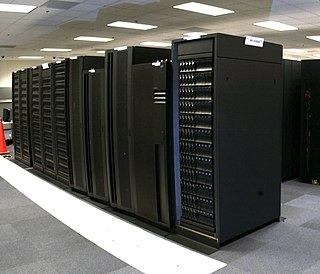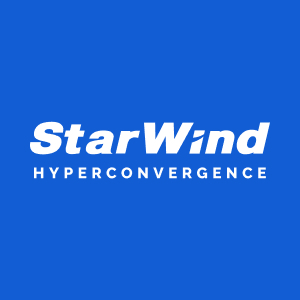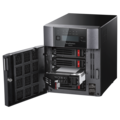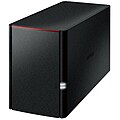Internet Small Computer Systems Interface or iSCSI is an Internet Protocol-based storage networking standard for linking data storage facilities. iSCSI provides block-level access to storage devices by carrying SCSI commands over a TCP/IP network. iSCSI facilitates data transfers over intranets and to manage storage over long distances. It can be used to transmit data over local area networks (LANs), wide area networks (WANs), or the Internet and can enable location-independent data storage and retrieval.

Network-attached storage (NAS) is a file-level computer data storage server connected to a computer network providing data access to a heterogeneous group of clients. The term "NAS" can refer to both the technology and systems involved, or a specialized device built for such functionality.

A disk enclosure is a specialized casing designed to hold and power disk drives while providing a mechanism to allow them to communicate to one or more separate computers.

The USB mass storage device class is a set of computing communications protocols, specifically a USB Device Class, defined by the USB Implementers Forum that makes a USB device accessible to a host computing device and enables file transfers between the host and the USB device. To a host, the USB device acts as an external hard drive; the protocol set interfaces with a number of storage devices.

QEMU is a free and open-source emulator. It emulates the machine's processor through dynamic binary translation and provides a set of different hardware and device models for the machine, enabling it to run a variety of guest operating systems. It can interoperate with Kernel-based Virtual Machine (KVM) to run virtual machines at near-native speed. QEMU can also do emulation for user-level processes, allowing applications compiled for one architecture to run on another.
sysfs is a pseudo file system provided by the Linux kernel that exports information about various kernel subsystems, hardware devices, and associated device drivers from the kernel's device model to user space through virtual files. In addition to providing information about various devices and kernel subsystems, exported virtual files are also used for their configuration.

Direct-attached storage (DAS) is digital storage directly attached to the computer accessing it, as opposed to storage accessed over a computer network. DAS consists of one or more storage units such as hard drives, solid-state drives, optical disc drives within an external enclosure. The term "DAS" is a retronym to contrast with storage area network (SAN) and network-attached storage (NAS).
The NSLU2 is a network-attached storage (NAS) device made by Linksys introduced in 2004 and discontinued in 2008. It makes USB flash memory and hard disks accessible over a network using the SMB protocol. It was superseded mainly by the NAS200 and in another sense by the WRT600N and WRT300N/350N which both combine a Wi-Fi router with a storage link.

My Book is a series of external hard drives produced by Western Digital. There are currently nine series of My Book drives; Essential Edition, Home Edition, Office Edition, Mirror Edition, Studio Edition, Premium Edition, Elite Edition, Pro Edition, AV Dvr "Live Edition", and the World Edition.
TrueNAS is the branding for a range of free and open-source network-attached storage (NAS) operating systems produced by iXsystems, and based on FreeBSD and Linux, using the OpenZFS file system. It is licensed under the terms of the BSD License and runs on commodity x86-64 hardware.

The IBM Storage product portfolio includes disk, flash, tape, NAS storage products, storage software and services. IBM's approach is to focus on data management.
Melco Holdings Inc. is a family business founded by Makoto Maki in 1975 and is located in Japan. The company's most recognizable brand is Buffalo Inc.

On Linux, network block device (NBD) is a network protocol that can be used to forward a block device from one machine to a second machine. As an example, a local machine can access a hard disk drive that is attached to another computer.

A storage area network (SAN) or storage network is a computer network which provides access to consolidated, block-level data storage. SANs are primarily used to access data storage devices, such as disk arrays and tape libraries from servers so that the devices appear to the operating system as direct-attached storage. A SAN typically is a dedicated network of storage devices not accessible through the local area network (LAN).

The SheevaPlug is a "plug computer" designed to allow standard computing features in as small a space as possible.

Thecus Technology Corporation (Thecus) is a Taiwanese multinational corporation that designs and markets Network-Attached Storage (NAS), Direct-attached storage (DAS), and Network Video Recorders (NVRs). Thecus is best known for producing NAS and creates and designs its own hardware, firmware, and accessory software. Thecus's products are distributed worldwide and localized in several languages. Thecus's headquarters are located in Taipei, Taiwan with subsidiaries located around the world.

In computing, Linux-IO (LIO) Target is an open-source implementation of the SCSI target that has become the standard one included in the Linux kernel. Internally, LIO does not initiate sessions, but instead provides one or more Logical Unit Numbers (LUNs), waits for SCSI commands from a SCSI initiator, and performs required input/output data transfers. LIO supports common storage fabrics, including FCoE, Fibre Channel, IEEE 1394, iSCSI, iSCSI Extensions for RDMA (iSER), SCSI RDMA Protocol (SRP) and USB. It is included in most Linux distributions; native support for LIO in QEMU/KVM, libvirt, and OpenStack makes LIO also a storage option for cloud deployments.

OpenMediaVault (OMV) is a free Linux distribution designed for network-attached storage (NAS). The project's lead developer is Volker Theile, who instituted it in 2009. OMV is based on the Debian operating system, and is licensed through the GNU General Public License v3.

StarWind Software, Inc. is a privately held Beverly, Massachusetts-based computer software and hardware appliance company specializing in storage virtualization and software-defined storage.

XigmaNAS is network-attached storage (NAS) server software with a dedicated management web interface. It is free software under the terms of the Simplified BSD license.





























